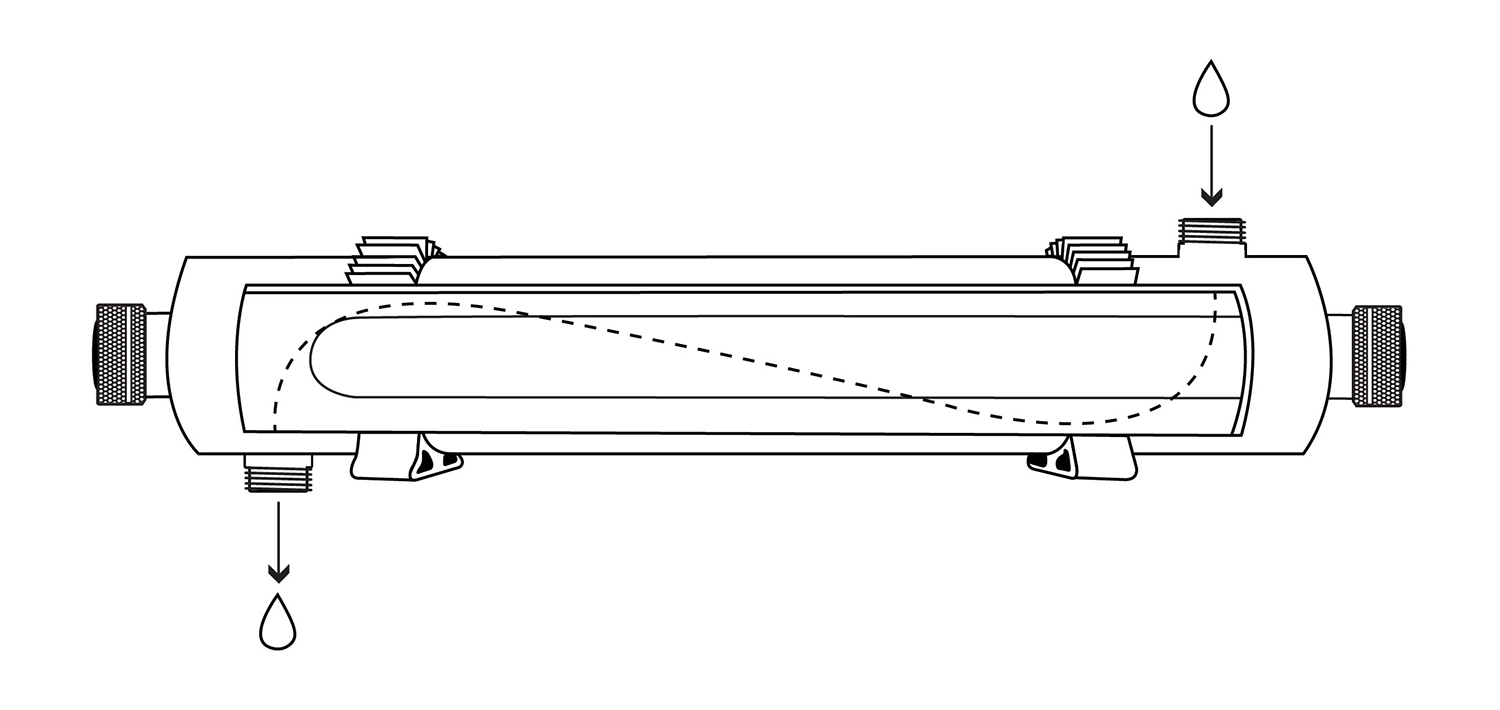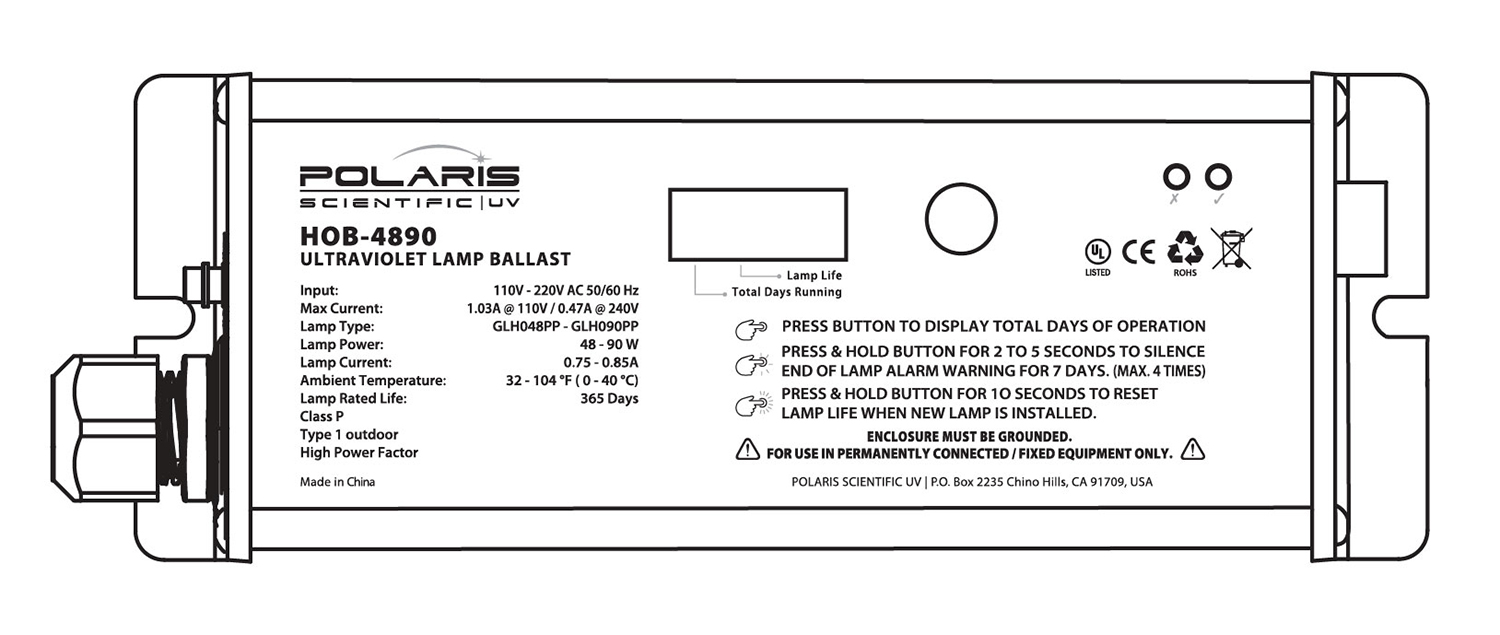Absolute VS Nominal Filters
Basics of waterborne diseases
Bubble point definition
Chemical adsorption of carbon
Granular activated carbon fact sheet
How do carbon filter work?
Water Softener – How do they work? – FAQs
What is a filter Beta Ratio
What is Osmosis and Reverse Osmosis
Water Glossary
What is Ultrafiltration
What is Ultraviolet water treatment?
The ultraviolet (UV) treatment process is an extremely quick process where light mutates and/or degrades DNA. DNA is the part of the cell that gives an organism instructions on how to function and reproduce. Once DNA is damaged, organisms become unable to function, reproduce, and cannot cause infection. The organism is rendered harmless and eventually dies.

In the UV disinfection process, water runs through a stainless steel chamber (also called a “reactor”) that contains a special ultraviolet -producing lamp that sterilizes the water. When the water flows past the lamp, the microbes in the water receive a lethal dose of UV, making the water safe to drink. However, different organisms require different levels of UV energy to disrupt their DNA, this energy level is known as a UV Dose.
HOW DO YOU CALCULATE UV DOSE?
UV Dose is expressed in microjoules (mJ/cm2 or mWs/cm2), the accepted standard for most applications is 30 mJ/cm2. If there is a slower flow rate it will result in a higher UV dose and the longer the chamber and the longer the water stays in contact with the germicidal UV lamp, the higher the dose. Intensity is the quantity of UV light per unit area, and time is the amount of “contact time:” the water spends in the chamber. By calculating the UV light intensity and time determines the UV dose.
Most UV manufacturers have a variety of systems suitable for different dose requirements.
Your system design will depend on the type of microorganism you are dealing with. Its best to consult a water treatment professional to ensure that you are getting the right kind of system for your needs.
FACTORS THAT AFFECT UV DOSE
Here are different factors can affect UV dose and the ability of UV to deactivate organisms in the water. If there is turbidity (large amounts of particles) or water hardness, microorganisms can “hide” behind these particles which hampers UVT, or UV Transmittance, the amount of UV that actually penetrates the water. A low UVT, “hidden” microorganisms will not receive the required dose of UV light to deactivate their DNA, and the water will not be properly disinfected.
To indicate what type of pre-treatment a UV system requires to increase UVT and produce maximum effective disinfection, a water test should be done. Below you will find a chart that shows the ideal state for maximum results:
| PARAMETER | INFLUENCE / EFFECT | LIMITS |
| UV Transmittance | Measure of absorption of UV light, UVT can affect system sizing requirements | > 75% UVT @ 254nm |
| Iron | Can affect both UVT and sleeve fouling | < 0.3 ppm (0.3 mg/L) |
| Hardness | Can cause sleeve fouling | < 120 ppm (7 gpg) |
| Turbidity | Can shield pathogen, post UV contamination | < 1 NTU |
| Tannins | Can affect UVT and system performance | < 0.1 ppm (0.1 mg/L) |
For NSF 55 Class A requirements (check with your local municipal health region), UV dose is required to be 40 mJ/cm2. If you aren’t sure if you are required to use an NSF-certified system for regulatory requirements in your area, ask your local water treatment professional to further assist you. They will be able to inform you about any laws or regulations that regulate water treatment equipment where you live.
An ultraviolet disinfection system (UV system) is a chemical-free, highly effective (to 99.9%) method to remove the threat of microbiological contaminants from water.
MAIN COMPONENTS OF A UV SYSTEM
There are a variety of UV disinfection systems and all contain the same general components, from the very large systems that disinfect water for commercial or industrial operations, right down to an under-sink system treating drinking water at the point of use.
THE FOUR MAIN COMPONENTS:
- Ballast Controller
- Water Chamber
- Germicidal UV Lamp
- Quartz Sleeve
These four components are the basis of all UV systems, although there are other optional parts such as sensors and solenoid valves that can also be a part of a system.
BALLAST CONTROLLER
The ballast controller is the part of the unit that controls the electrical output of the lamp, and powers it to produce UV-C light. The ballast controller varies in complexity and size, but essentially, they all do the same thing. Some ballast controllers are very simple and are a simple cap that fits over the end of the lamp and a plug. Other ballast controllers, depending on the type of UV system, are more complicated, and have lamp-change timers, low-UV alarms, or trouble indicator lights to show when the system is not performing as it should.

Each UV system manufacturer has its own characteristics when it comes to their system performance. If it’s time to change your lamp on your UV system, be sure to use a branded replacement lamp. Using cheap generic replacement lamps can end up causing more issues than the amount of money they might save you, and for most manufacturers, they will void your product warranty.
WATER CHAMBER
The water chamber, also known as just a chamber or a reactor, is the part of the system that physically houses the germicidal UV lamp and sleeve, and also controls the flow of water through the system.
The water chambers are usually constructed of stainless steel, but some manufacturers use different materials which include axial or boot shape, and reactors come with ports in a variety of sizes depending on the model and the flow rate the system is intended to service.
All chambers perform the same function, no matter how they look aesthetically whether it’s different types of welds, end caps, and other design features.
GERMICIDAL UV LAMP
Essentially, all germicidal UV lamps perform the same function of producing UV-C, which is the wavelength of UV light, depending on the application and disinfection requirements.

All germicidal UV lamps, regardless of output, contain mercury. Mercury in high levels is definitely dangerous, but germicidal UV lamps generally contain a bead of mercury about the size of the head of a pin, and all lamps can be recycled, much like the fluorescent light bulbs that you can purchase at the local retail store.
During operation of the lamp, the mercury is completely contained within the lamp structure, and with proper recycling, these lamps are harmless and provide no risk to the environment. Mercury is a key part of the lamp’s ability to produce the germicidal UV-C light wavelength, minute liquid mercury droplets collect at the lamp’s “cold spot”, and once they reach peak temperature, UV-C light is produced.
Just like a regular light bulb, all germicidal UV lamps have filaments to produce an electrical current that heats up the mercury and evaporates it into the air inside the lamp. The evaporated mercury creates electrical arcs that produce UV-C at varying intensity levels to disinfect water.
There are three main types of germicidal UV lamps available to the residential and light commercial markets.
Low-pressure standard germicidal UV lamps – These lamps are most often used in a residential home where the flow rates are lower, and exposure times can be longer. They are lower cost to replace, and generally the initial equipment cost is much lower as well.
Low-pressure high output (HO) lamps – HO lamps are used in higher dosages or flow rates are required, but still have a smaller footprint. They treat water with a broader tolerance to temperature (temperature can affect lamp performance) and the lamps are often used in larger flow applications or light commercial systems.
Low-pressure amalgam lamps – These lamps use mercury amalgam mix to control vapor pressure and use a slightly different process to yield up to three times the UV-C output of a standard low-pressure lamp of the same length. Predominantly, these lamps are used in more commercial-type applications or for regulations requirements, depending on the type of microbiological contamination being treated.
There are also medium-pressure germicidal UV lamps which are exclusively used for larger-scale operations and have essentially no application in the residential market. These are the types of lamps that are used in drinking water and wastewater treatment plants.
Different lamps from various manufacturers will use different types of glass in the lamp structure, you will either find soft glass, or harder quartz glass. Soft glass can be less costly, however due to harder nature of quartz glass, it’s much less likely to break. Soft glass may also cloud with time, and this transmits less germicidal UV-C through to the water, rendering it less effective as it ages. Quartz glass transmits UV more effectively because it is less likely to cloud. Both types of glass are coated to help increase their UV-C transmission.
QUARTZ SLEEVE

The quartz sleeve is a long, cylindrical tube of quartz glass that protects the germicidal UV lamp which is powered by electricity from the flow of water. The lamp is inserted into the tube and transmits the light through the tube into the water. Sleeves should be cleaned whenever the lamp is changed because sleeves can foul with minerals and other contaminants over time.
